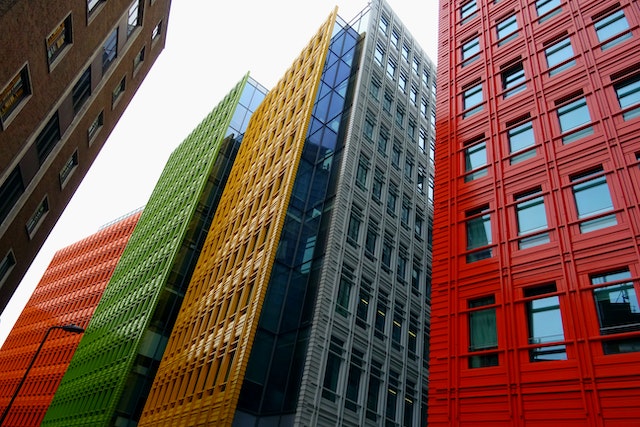Posted on January 31st, 2023

The use of color in an office space has a significant impact on the atmosphere of the workplace and on those that occupy it. The right combination of colors can enhance the overall design, improve the functionality of the space, and create a more positive and productive work environment.
According to the Institute for Color Research, within 90 seconds of first viewing, people make a subconscious judgement about a space or a product, and between 62% and 90% of that evaluation is based only on color. Additionally, in a ground-breaking study, the University of Texas discovered that when presented with different colors, varying brain responses can affect employee productivity and attitude.
In this article, we will discuss the power of color in offices by delving into the evidence surrounding color psychology, and the impact lighting and materials have on color, and how this should combine to be applied to office design. So, after reading, office interior designers, occupiers and landlords should gain some insight into how to use color to enhance the overall design of spaces, and improve the functionality and productivity of the office environment.
Read More »
Tags: 2023, Business, Business Advice, commercial property, Commercial Real Estate, Office Health, Office Organization, Office Space, Office-tips
Posted in Office Health, Office Renovation | No Comments »
Posted on January 24th, 2023

The Midwest region of the United States is home to some of the most impressive and versatile event spaces in the country. Whether you’re planning a large corporate conference, a small business meeting, or a full-scale trade show, the Midwest has something to offer for everyone. In this post, we’ll be highlighting the top ten Midwest conference and convention centers that will be sure to impress your attendees and make your event a success. From state-of-the-art facilities with stunning architecture to versatile and modular spaces, these centers have it all. So, without further ado, let’s dive in and explore the best conference and convention centers the Midwest has to offer!
The Full List
McCormick Place
With more than 2.6 million square feet of space, McCormick Place is one of the largest conference venues not only in the Midwest, but in North America. The venue is located 3 miles away from Chicago’s Magnificent Mile, and can be easily accessed from the downtown area and from O’Hare and Midway airports.
McCormick offers conferencing and convention space in four buildings, which are interconnected for the convenience of visitors. The venue can accommodate assembly-style seating for 18,000 people, and additionally offers a 10,000-seat arena, three theaters with a capacity of 300 seats each, and a large theater that sits more than 4,000 attendees.
Read More »
Tags: chicago, Cobo Center, Collinsville, conference center, convention center, detroit, DuPage Expo Center, exhibition, expo, Frontier Airlines Center, Gateway Center, Illinois, Kellogg Hotel and Conference Center, Meetings, michigan, Midwest Conference Center, Ohio, oklahoma, presentation, Sawmill Creek Resort, seminar, St. Paul River Centre, state, The Reed Center, Tinley Park Convention Center, wisconsin
Posted in Cities & States, Meetings | No Comments »
Posted on December 23rd, 2022

Fun office events are a great way to improve team cohesion and general workplace wellbeing, all while building a sense of belonging amongst employees. These events can also be an opportunity to develop interpersonal skills and further instill your company’s values, particularly when they align with your overall ethos. A great example of this would be a wellness brand opting to take employees through a guided meditation or in-office yoga session.
Despite the recent rise of remote and hybrid work schedules, there is still a lot of importance placed on engaging staff through team building and promoting happy and inclusive work cultures. However, it’s important to note that best practices have shifted somewhat in recent times – away from standard corporate event ideas like Friday night work drinks or team lunches and towards more inclusive, diverse activities.
So, to inspire a packed calendar of enjoyable and engaging office events for your teams in the new year, we’ve curated a list of fun office events that stray away from tired and low-effort happy hours.
Hopefully, a few of these ideas can make an appearance in your office’s social calendar and, after their success, be recurring events that your employees will continue to look forward to during their many years of tenure. Looking for some fun corporate event ideas for your office to implement?
Read More »
Tags: 2022, ideas, office events, Office Talk, team building
Posted in 2022, Events, Office Relations, Office Talk | No Comments »
Posted on December 8th, 2022

If you’re a remote worker, you know the importance of finding a good workspace. While home offices or public spaces can be great places to get work done, they often lack the necessary tools and facilities to help you be at your most productive. That’s where coworking spaces come in. Coworking spaces offer all the benefits of traditional office spaces, without the limitations of long lease terms. For a relatively low cost, coworking spaces provide remote employees with an oasis of productivity from which they can network, complete tasks, or even launch entirely new entrepreneurial endeavors, all whilst working alongside others and bouncing ideas off like-minded people.
A recent study by Zippia shows that, as of 2022, 66% of U.S. employees work remotely in some capacity, with roughly 36 million people expected to be working remotely across America by 2025. Moreover, this same study outlines that 16% of companies in the U.S. are fully-remote, a number that is expected to increase in years to come.
Read More »
Tags: coworking space, digital nomads, flexibility, networking, remote work, remote workers
Posted in Coworking Space, Office Talk, Remote Workers | No Comments »
Posted on November 30th, 2022
The impact of the pandemic can still be felt on multiple fronts, almost three years after its emergence in early 2020. One of the most noticeable of these impacts has been the proliferation of remote work and its influence on where people choose to live and work. Not so long ago, most people chose where they lived based on where they worked or where their industry was focused. Fast forward to the end of 2022, and it’s no longer as cut and dry as it once was.
In recent years, large cities and their suburban rings have lost some of the appeal that previously allowed them to attract employees and homeowners. Today, the rise of remote work and the decentralization of talent that it provides has given way to a surge in demand for both residential and commercial properties in areas that had previously flown under the radar.
Some pundits are saying that these changes are here to stay, so the question is – where are people living and working in a post-pandemic United States?

Read More »
Tags: 2022, austin, Dallas, decentralization, housing, Miami, mobility, Office Space, San Antonio, statistics, Texas, trends
Posted in Best Cities for Business in the USA, Office Talk, Trends and Statistics | No Comments »
Posted on November 15th, 2022
Sustainability practices and green buildings are more popular than ever, making a strong LEED rating extremely desirable to both building owners and prospective occupants. In this blog post, we’ll take a closer look at what the LEED certification system is, why it matters, and some of the benefits you can expect from going through the certification process.

What is LEED Certification and What Does It Stand For?
If you’re unfamiliar with the term, LEED certification is a stamp of approval from the United States Green Building Council (USGBC) that signifies that a building or renovation project meets their high standards for environmentally friendly and sustainable construction. The acronym LEED stands for Leadership in Energy and Environmental Design. To receive LEED certification, a building must score points in several different categories, including water usage, indoor air quality, energy efficiency, reduction of waste, and material selection. In addition, the building must also meet a minimum threshold for overall energy efficiency. While the standards for LEED certification are relatively high, the benefits of certification are significant. Buildings with LEED certification often enjoy lower operating costs, higher rents, and increased market value. As a result, the number of LEED-certified buildings has grown rapidly in recent years, as more and more developers seek to cash in on the green building boom.
Read More »
Tags: 2022, commercial property, leed, LEED certification, LEED platinum
Posted in 2022, CRE | No Comments »
Posted on November 8th, 2022

Dealing with a fixed-term lease agreement and looking to move offices or downsize? The topic of commercial lease transfer can be confusing to navigate, particularly when you are unsure of your rights and obligations under the lease.
If you’re renting a commercial property, you signed a contract at the beginning of your tenancy called a lease agreement, which contains all the details of your rights and obligations while occupying and conducting business operations at the commercial property. Your agent is required by law to give you a copy of the lease agreement if you don’t already have one.
The following article will serve as a full guide to commercial lease assignment, providing business owners with an overview of the legal considerations and elements required for an assignment of lease.
What is a Commercial Lease Assignment?
Also known as a lease transfer, a commercial lease assignment involves a tenant transferring all of their interests and rights in a lease to a new party. This new tenant will take on the responsibilities of the existing lease, including rent and any other obligations, leaving the original tenant free to exit the agreement.
Read More »
Tags: 2022, commercial lease assignment, commercial property, guides, landlords, lease transfer, Office Space, subleasing, tenants
Posted in 2022, Business Advice, Leases, Office Talk | No Comments »
Posted on October 28th, 2022

Even though Florida’s office sector held strong during the pandemic, some investors are now feeling cautious as a result of geopolitical tensions, inflation, reduced spending, and rising interest rates. Despite the cooling sentiment, vacancy rates for commercial spaces are continuing to decrease across the State, especially in the office market. Fuelling Florida’s continued market positive is an overall increase in jobs, combined with low unemployment rates and generally favorable business conditions.
Market Highlights
Asking rates in Miami Beach have increased significantly, with some offices costing more than $120 sq/ft. On average, however, actual rental prices for this premium market are much lower, at roughly $70 sq/ft.
Additionally, the vacancy rate for Miami Beach is relatively low at 12.7%, just behind Brickell and Wynwood. Consequently, there has been a recent uptick in development activity driven by those looking to take advantage of the favorable conditions. Some notable projects include 1177 Kane Concourse (101,000 sq/ft) and Terminal Island Office Project (161,000 sq/ft), slated for delivery in 2024.
Read More »
Tags: 2022, flexible office space, industrial space, Miami, office market, retail space
Posted in 2022, CRE, Market Overviews, Miami, Trends and Statistics | No Comments »
Posted on October 13th, 2022

Median Salary vs. Average Salary: How Much are Office Workers Really Paid?
Given the renewed relevancy of the office as a working environment, we believe it is a prudent time to examine how much the average American office worker earns, by age.
Median and average salary figures are both commonly used when exploring fair compensation in the workplace. Average salary data is determined by adding together all salaries earned by a particular group and dividing this figure by the number of people in the group, whilst median salary data is derived by arranging salaries from low to high and selecting the midpoint. A lot of people refer to these terms interchangeably, however, most prefer to compare salaries against the median wage – as it isn’t as impacted by the dramatic ends of the spectrum.
Read More »
Tags: 2022, administration, age, average salaries, office jobs, Office Space, pay, salary, statistics, wage
Posted in 2022, Office Relations, Office Talk, Salary Expectations, Trends and Statistics | No Comments »
Posted on September 21st, 2022
 The Las Vegas commercial real estate (CRE) market has continued its recovery and stabilization since emerging from the pandemic. Positive signs for Q2 2022 include reduction in vacancies, positive net absorption, increased asking rents, and the delivery of two projects adding 188,909 square feet (sq/ft) office space to the market.
The Las Vegas commercial real estate (CRE) market has continued its recovery and stabilization since emerging from the pandemic. Positive signs for Q2 2022 include reduction in vacancies, positive net absorption, increased asking rents, and the delivery of two projects adding 188,909 square feet (sq/ft) office space to the market.
Strong pre-leasing and inquiry numbers for planned and under-construction projects, along with a rise in companies looking to the Las Vegas Valley to expand or relocate operations entirely, round out the positive sentiment currently seen in the market.
For office product in particular, Las Vegas saw a Q2 of mixed results. On the back of some notable expansion in Q1 2022, Southern NV’s office market has appeared to cool at mid-year. Investment prices reached record levels, however, vacancy rates edged higher. The Southwest submarket continues to see rising rents and additional leasing activity as tenants continue to funnel to this historically popular region.
There are currently 4,660 CRE spaces for lease in Las Vegas, amounting to 41.5 million square feet of space. Out of the 1280 commercial buildings available for sale, 505 have been leased in the past month, with 12 new listings coming onto market at time of print.
Key Takeaways
- Total inventory under construction – 468,400 square feet
- Overall vacancy – 12.7% (a rise from 12.5% in Q1)
- Net absorption – negative 284,323 square feet
- Availability – 6.2 million square feet
- Average asking rents – $28.50 per square foot per year (a decline of $0.02 from Q1)
- Investment sales – $50.5 million (down from $75.5 million in Q1)
Read More »
Tags: 2022, Class A, Class B, Class C, coworking report, economic reports, Las Vegas, nevada, office market report, Q2
Posted in CRE, Las Vegas, Market Overviews, Nevada | No Comments »









 The Las Vegas commercial real estate (CRE) market has continued its recovery and stabilization since emerging from the pandemic. Positive signs for Q2 2022 include reduction in vacancies, positive net absorption, increased asking rents, and the
The Las Vegas commercial real estate (CRE) market has continued its recovery and stabilization since emerging from the pandemic. Positive signs for Q2 2022 include reduction in vacancies, positive net absorption, increased asking rents, and the